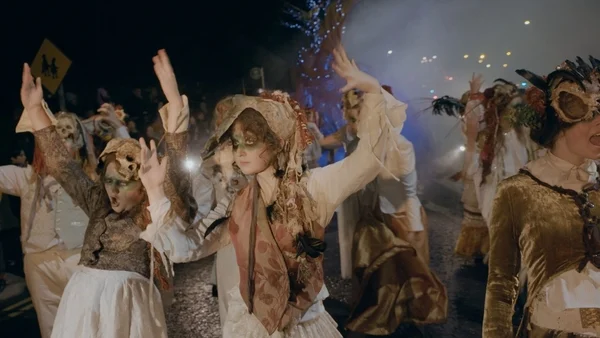Oct 28,2024

Edwina Guckian cut her teeth on Irish folklore and mythology. Literally.
"It's actually how I lost my first tooth", she tells me over the phone, remembering the games she and her family would play around Halloween, like trying to take a bite out of an apple tied up with string. "They couldn't find my tooth anywhere and it was stuck in the apple."
Ducking for coins and apples, Blind Man's Bluff and "the premonitions of seeing people in the mirror of who you might marry or touching the different containers of soil or water or if you're going to go overseas or if you're going to marry soon to get the ring" were all traditions her family held to during Halloween, ones that hark back to our shared - if somewhat forgotten - ancestral past.

Guckian, a dancer, artist, farmer and folklorist, is one of a number of experts featured in Na Féilte Tine (The Fire Festivals as Gaeilge), a new four-part series exploring the four indigenous Irish festivals of Samhain, Imbolg, Bealtaine and Lúnasa.
These sacred festivals were how generations of Irish families measured the year over millennia, and are richly imbued with mythology, symbolism and wisdom.
Guckian was raised entrenched in lessons from the past, whether its celebrating Bonfire Night or respecting the fairies and their sacred hawthorn tree. That said, she notes that she grew up not "knowing that this is folklore".
"That was just a way of life for our family, as it was for all of the older generation, and I grew up with the older generation."
As she entered adulthood, Guckian says she started appreciating how not every Irish person of her generation grew up with that knowledge passed down. She decided to use the teachings in her work as an artist, "giving them a purpose in today's world, because if they don't have a purpose in today's world, they're just never going to survive".
Halloween, and its heavily Americanised traditions, may be in full swing now but there are countless Irish traditions that we can bring back to the 21st century - which many people already do. Chief among them is carving turnips instead of pumpkins.
We need your consent to load this Instagram contentWe use Instagram to manage extra content that can set cookies on your device and collect data about your activity. Please review their details and accept them to load the content.Manage Preferences
"People carve out pumpkins these days, because they're much easier to carve than a turnip, you'd take a finger off yourself. But the turnip for the lanterns would have been one of the really big ones years ago, and they look way more creepy."
Rest, community and storytelling was key to what Guckian calls "the dark half of the year" around Samhain, a time when, whether we liked it or not, neighbours would call around after the animals were brought in from the fields to rest.
"People would ramble to each other's houses and tell stories, not just the news, but actually tell fairy and ghost stories by fire. Uninvited, of course..."
Being raised on a farm, Guckian is especially aware of the role nature plays in Samhain, and the fire festivals in general, something she hopes people will consider anew.
"Prior to this, everybody was self-sustaining and lived off the land, on the land, whereas today we live out of Tesco. It's so different. An important harvest, important of being able to feed themselves and feed their animals that provided for them was like survival. It was so central to life.
"That's my father's generation. He was only born in '50s. So it's not all that long ago that people still lived like that. It's just completely changed when my generation came along."
When we lose these habits and rituals, Guckian says, we lose more than just stories and jokes. We lose connection, "not just from nature and land, but from people around you".

"Everybody is just in their own bubble, locked away in their houses or in their phones. And they don't need to go get the news from the person down the road because they have it at their fingertips."
Looking back at these traditions is more than just remembering our history, it can be a way of guiding our lives now. "I think we need to look back to all the ways for us to be sure that as a human race, that we're here in the future. Because if we continue to kill nature at the rate we're going and spray everything and it's just decimating our land, then I just don't think we're going to be here.
"We really have to look back if we want to be able to move forward."
.svg)
